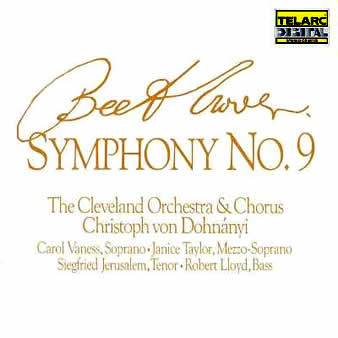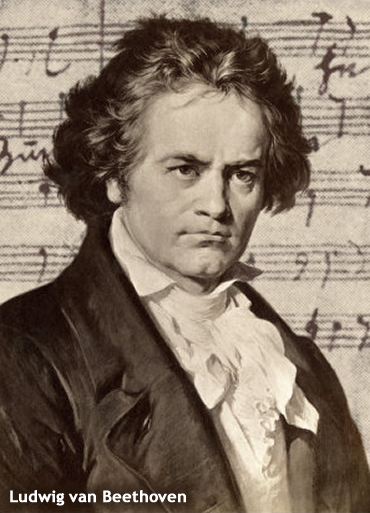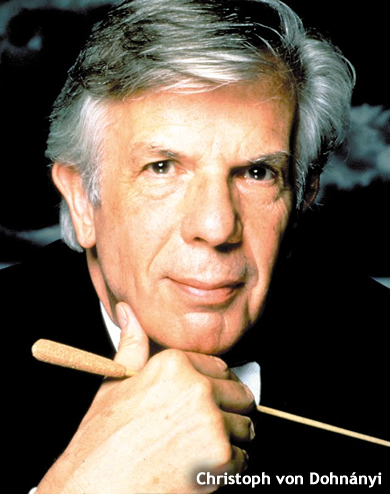 Ludwig Van Beethoven (1770-1827)
Ludwig Van Beethoven (1770-1827)
Symphony No. 9 in D Minor, Opus 125 – “Choral”
The Cleveland Orchestra (Christoph Von Dohnanyi, conductor)
Recorded in Masonic Auditorium, Cleveland on October 18 & 19, 1985
ONE-SENTENCE REVIEW:
This CD will receive my highest rating (88 Points!) for nostalgia reasons alone – this was the first CD I ever had (most kids my age were listening to Madonna) and I listened to it over and over and over again – simply amazed at the clarity and “awesomeness” of the new CD technology.
ORIGINAL LINER NOTES (written by Steven Ledbetter):
Scarcely had Friedrich Schiller’s ode An die Freude (To Joy) reached print in 1785 before composers started setting it to music, so strongly did its theme of world brotherhood and Enlightenment ideals speak to the young and idealistic.
Soon there were dozens of versions, mostly for voice and piano, so the poet can hardly have been surprised to learn through a friend in Bonn that yet another young composer was about to set his text to music. But this one was different; the friend noted: “I expect something perfect, for as far as I know him he is wholly devoted to the great and sublime.”
 The composer was Ludwig van Beethoven, then in his early twenties. Three decades elapsed before Beethoven was satisfied that he had found the way to deal with Schiller’s text, but certainly the resulting work – his final symphony – was “great and sublime.”
The composer was Ludwig van Beethoven, then in his early twenties. Three decades elapsed before Beethoven was satisfied that he had found the way to deal with Schiller’s text, but certainly the resulting work – his final symphony – was “great and sublime.”
After completing his Seventh and Eighth Symphonies in 1812, Beethoven had turned away from the genre for five years, and only began thinking about symphonies again when he received an invitation to come to London in the winter of 1817-18 and to bring two new symphonies with him. The invitation must have been attractive – it was just such a trip to England that had made Haydn a wealthy man – but in the end nothing came of it except a few sketches for two symphonies.
Several more years passed, Beethoven returned to his sketches in the summer of 1822, still planning to compose a pair of symphonies. But by the following year he had settled on a single work in the key of D Minor.
For a long time he was torn between two possible endings – one purely instrumental, the other a choral setting of Schiller’s ode. The problem, as he saw it, was how to motivate the sudden appearance of a chorus after three lengthy instrumental movements. Even after he had invented the familiar hymnlike tune and drafted the instrumental variations that mark its first appearance, he could not find a solution.
One day he was struck by the idea of having a soloist simply sing the announcement, “Let us sing the song of the immortal Schiller,” before starting the ode itself.
In the end he settled on slightly different wording, but the point was the same: to disavow the past and turn with a conscious welcome to something new and liberating. Once he actually started setting Schiller’s words, he treated them very freely, taking the passages that particularly stimulated his muse, making cuts and repetitions as the musical development required. In the end, he actually set something less than half of Schiller’s entire text and freely rearranged the rest.
 The planning of the first performance was complicated by the fact that Beethoven wanted to conduct the entire concert, an embarrassment on account of his deafness.
The planning of the first performance was complicated by the fact that Beethoven wanted to conduct the entire concert, an embarrassment on account of his deafness.
In the end he stood on stage next to Michael Umlauf, ostensibly to set the tempi, and, though he kept beating through the work, the players had been instructed to pay attention only to Umlauf’s beat.
The remainder of the all-Beethoven program included the overture Consecration of the House and three movements of the Missa Solemnis. The plan to perform part of the Mass ran into legal entanglements when Church authorities refused permission for liturgical music to be heard in the unsanctified precincts of a theater. In the end, that music was billed (in a mild subterfuge) as “Three Grand Hymns with Solo and Choral Voices.”
Though the music was of unprecedented difficulty, the crowds in the Kartnertor Theatre on May 7, 1824 responded with enthusiasm, cheering and applauding energetically, though the deaf composer, still turning the pages of the score and hearing the music in his mind, was unaware of it until one of the soloists pulled him by the sleeve to get his attention and pointed to the audience.
Like the Fifth Symphony, Beethoven’s Ninth moves from tragedy to triumph symbolized by the beginning in D minor and the close in D major. But the Fifth seems to be the triumph of an individual hero, while the Ninth, with a chorus singing Schiller’s text, becomes a universal triumph for human aspiration.
Though the text makes explicit the message of the symphony, Beethoven’s musical architecture reinforces and projects that message with unusual force. He planned the entire symphony in such a way that for the first three movements it remains locked in the realm of D minor and the closely related keys F and B-flat (they are part of the scale of D minor).
Late in the final movement F and B-flat are ousted in favor of F-sharp and B natural, notes that characterize the scale of D major. On paper this sounds like purely theoretical change, but in performance it achieves unparalleled force. Rarely in the history of music has simple harmonic relationship between major and minor modes generated greater power or feeling.
 The symphony opens with its first theme gradually appearing out of a mysterious introduction hinting at indescribable vastness. No orchestral beginning was more influential throughout the nineteenth century, though no composer has ever surpassed Beethoven in the suggestive power of this opening. And throughout the lengthy first movement, Beethoven never allows us to stray for long from powerful reminders that his symphony is in a minor key.
The symphony opens with its first theme gradually appearing out of a mysterious introduction hinting at indescribable vastness. No orchestral beginning was more influential throughout the nineteenth century, though no composer has ever surpassed Beethoven in the suggestive power of this opening. And throughout the lengthy first movement, Beethoven never allows us to stray for long from powerful reminders that his symphony is in a minor key.
The demonic scherzo of the second movement, too, fiercely reiterates the fearing of the first movement. For a moment in the middle section, Beethoven projects pure human joy in the first extensive passage in D major, but it is cancelled by the return of the scherzo.
The richly evocative lyricism of the third movement sings a pensive song in B-flat, alternating with a second, slightly faster theme in D major. But on every occasion the second theme ends up slipping helplessly back to the first key, though the variations become ever more lush and sweetly consoling.
The first sound of the finale is a “fanfare of terror” introducing Beethoven’s public search for a way to turn the minor key darkness of the opening into a firm major key conclusion. Cellos and double basses sing an operatic-style recitative (for which Beethoven originally wrote words) calling up and summarily rejecting themes from each of the earlier movements.
Finally a new idea appears, simple, singable, hymnlike, emphatically in D major (since its melody circles around F-sharp, the characteristic third step of the D major scale). The orchestra welcomes it with a set of variations. Real progress seems to be underway when this theme, too, is swept away by a renewed “fanfare of terror,” brutal and consciously ugly, containing almost every note of the D minor scale!
Here, at last, the baritone intervenes with Beethoven’s introduction to Schiller’s poem. The soloist, echoed by the chorus, sings confidently in D major, and all seems well through three stanzas of Schiller’s poem. But one more crisis remains.
 At the end of the third stanza (on the words “von Gott” – “before God”), Beethoven undercuts his modulation to the expected dominant key and throws the following passage into B-flat – once again threatening that the minor mode may prevail.
At the end of the third stanza (on the words “von Gott” – “before God”), Beethoven undercuts his modulation to the expected dominant key and throws the following passage into B-flat – once again threatening that the minor mode may prevail.
The “Turkish” march of the tenor’s solo is a melodic variant of the main theme turned into a heroic aria. An extended orchestral development follows with major and minor engaged in a last dramatic opposition.
Finally the orchestra settles on a dotted rhythm repeating the note F-sharp through three octaves – the single note that most strikingly emphasizes the main theme and its major mode harmony. After two tentative beginnings in the “wrong” key, the composer changes a single note in the bass part and suddenly “realizes” that this music is, emphatically, in D major.
The chorus returns in one of the most thrilling moments in all of music, asserting through the rest of the symphony Beethoven’s sturdy, confident answer to the questions posed by the opening.
TRACK LISTING – BEETHOVEN SYMPHONY NO. 9 ‘CHORAL’
- 1: Allegro ma non troppo un poco maestoso [15:05]
- 2: Molto vivace – Presto [11:27]
- 3: Adagio molto e cantabile [14:57]
- 4: Presto [24:32]
Here’s a video treat! Note: This is not the performance being reviewed.
http://www.youtube.com/watch?v=IInG5nY_wrU
FINAL THOUGHT:
I firmly believe it was this recording of Beethoven’s 9th by the Cleveland Orchestra conducted by Christoph Von Dohnanyi that got me hooked on classical music. I was 10 years old when I first heard this. By giving this disc to me, my parents created a classical music monster as I started to collect and listen to almost anything I could get my hands on. (I wasn’t a total freak – I also listened to Madonna and Culture Club – though maybe THAT makes me a total freak.)
 Emily Sachs – President – Manka Music Group (A division of Manka Bros. Studios – The World’s Largest Media Company)
Emily Sachs – President – Manka Music Group (A division of Manka Bros. Studios – The World’s Largest Media Company)



Thanks for an interesting blog. What else may I get that sort of info written in such a perfect approach? I have an undertaking that I am just now operating on, and I have been on the lookout for such info.gps tracker for kids’
I think this is among the most significant info for me. And i am glad reading your article. But want to remark on few general things, The web site style is great, the articles is really excellent gps tracker for kids’